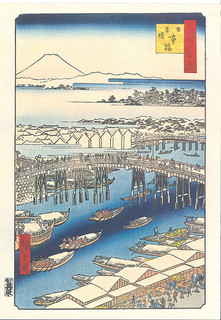Nihonbashi
- Built: 1603
- Japanese: 日本橋 (Nihonbashi)
Nihonbashi is a bridge in Tokyo at the center of one of the country's most major commercial districts. Originally built in 1603 as a huge and iconic wooden bridge, Nihonbashi was designated the official starting point of the Gokaidô (five major highways of Edo period Japan) the following year,[1] and the point from which all distances to/from Edo (and now Tokyo) were officially measured. The bridge was at the center of one of Edo's chief merchant districts; in the Meiji period, the wooden bridge was replaced with a stone one, decorated with bronze street lamps in the style of the time. The district is known in particular as the location of the honten, or main branch, of many of Japan's major department stores, as well as many other major commercial establishments.
Today, the Metropolitan Expressway passes over the bridge, covering it in shadow. There are rumors, however, of plans to open up the bridge to the sunlight, or to rebuild the wooden bridge.
History
Nihonbashi was first built in 1603, not over the Sumidagawa (Sumida River) which marked the eastern border of the city of Edo, but across a much smaller waterway to the west of the Sumida, and east of the castle; the waterway was so minor it had no name, and so came to be known as the Nihonbashi-gawa, after the bridge.
The bridge's name, Nihonbashi, was originally written with the characters 二本橋, meaning "two bridges" (or perhaps referring to the bridge's double-width). The bridge was 28 bays (just over 50 meters) long, and was remarkably wide at four bays two shaku (about eight meters), allowing a great many people to cross at once, and making the bridge a center of activity.
When the bridge was renovated in 1659, following the 1657 Great Meireki Fire, the new name 日本橋 took root, indicating an association of the bridge with the entire realm, and marking the bridge and its construction as a major symbol of Edo's importance and newly central location. It was at this time as well that the shogunate officially made Nihonbashi the official center of the city, and the point from which distances were to be measured.[2]
The bridge curved high in the center, and provided views of Edo castle to the west, along the waterway, which was lined with official shogunate storehouses; Mt. Fuji was often visible in the distance, behind the castle. One of the chief shogunate offices for dispatching post-horses was located near the bridge.[1]
A former ward of the city, Nihonbashi-ku, was named after the bridge.
The current stone bridge was built in 1911, and is 49 meters long and 27 meters wide.
| Preceded by: None |
Stations of the Tôkaidô | Succeeded by: Shinagawa |
| Preceded by: None |
Stations of the Nakasendô | Succeeded by: Itabashi |
| Preceded by: None |
Stations of the Nikkô Dôchû | Succeeded by: Senju-juku |
| Preceded by: None |
Stations of the Ôshû Kaidô | Succeeded by: Senju-juku |
| Preceded by: None |
Stations of the Kôshû Kaidô | Succeeded by: Naitô Shinjuku |
References
- "Nihonbashi." Sekai daihyakka jiten 世界大百科事典. Hitachi Solutions, 2012.
- Screech, Timon. "An Iconography of Nihon-bashi." in Olschleger, Hans Dieter (ed.) Theories and Methods in Japanese Studies: Current State and Future Developments. Bonn University Press, 2007. pp323-336.

